The Samsung Galaxy Note 4 Review
by Joshua Ho on October 15, 2014 9:00 AM EST- Posted in
- Smartphones
- Samsung
- Android
- Mobile
- Galaxy Note 4
Battery Life
Battery life is one of the most important aspects of any mobile device, especially because the battery is what defines mobility to begin with. As a result, it’s important to test battery life in a meaningful manner. This requires a repeatable test with standardized conditions, and a range of scenarios that stress different aspects to get the full picture. Most importantly, for tests that have the display on we calibrate the display to 200 nits to ensure that the test doesn’t penalize brighter displays. In the case of the Galaxy Note 4, we see about a 3% gain in battery capacity, so most of the battery life gains should come from higher efficiency.
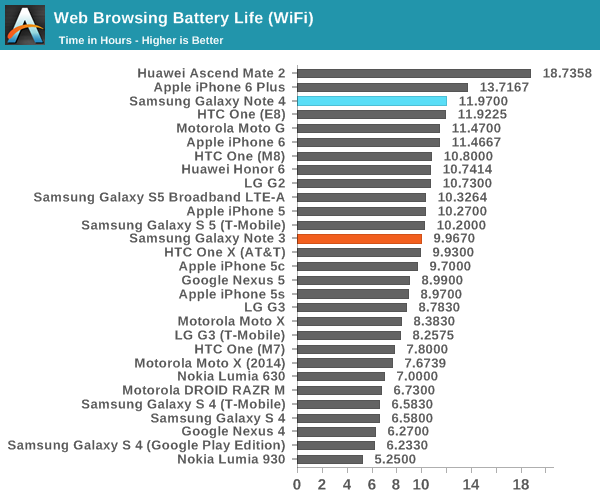
Our first test is the WiFi web browsing test, which loads a given set of web pages in a loop, with special emphasis taken in order to ensure that the test doesn’t penalize faster SoCs, which would have significant effects on our results. As one can see above, the Galaxy Note 4 has a noticeable uplift in battery life when compared to the Galaxy S5 and lasts significantly longer than the Galaxy Note 3. It doesn’t last quite as long as the iPhone 6 Plus, but few people should have issues getting through a full day of intensive use.
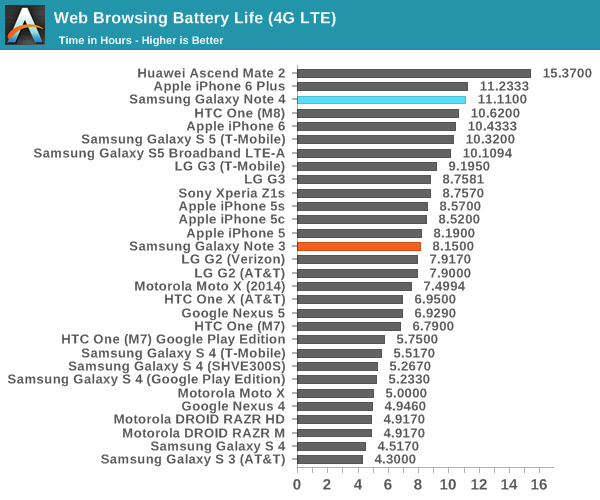
On LTE web browsing, a similar story plays out as the Galaxy Note 4 is able to keep up with the competition and delivers the massive improvement that we’ve generally seen from the transition to Snapdragon 801 and 805.
While the web tests are well-worn by now, we’ve added two additional tests to the battery life suite in order to get a better picture of SoC-bound battery life. To this end, we use an infinite loop of T-Rex on-screen to replicate a GPU-intensive scenario and Basemark OS II’s battery life test to simulate a CPU-intensive scenario.
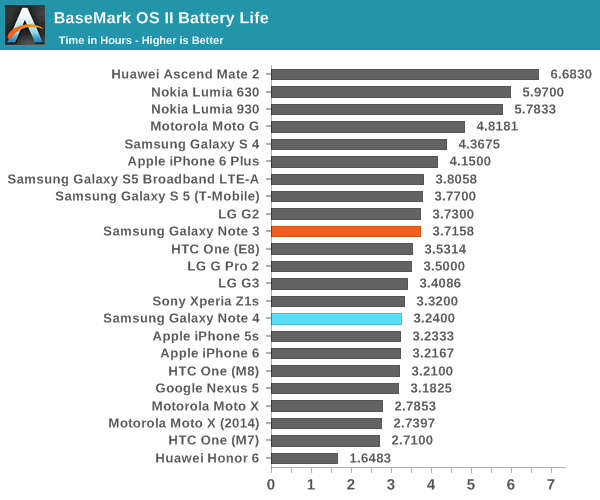
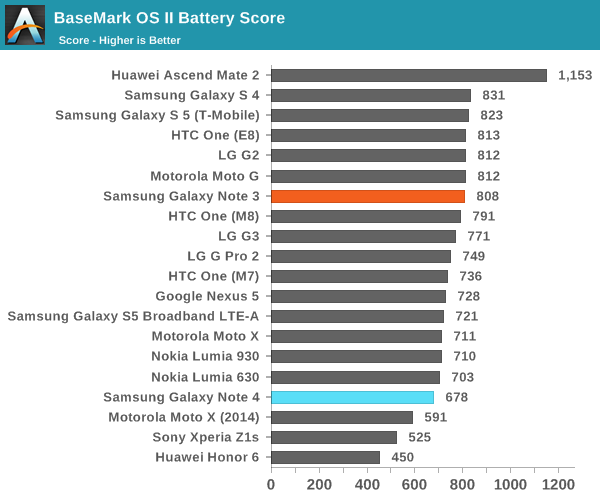
In the case of the Basemark OS II test, we see that battery life under a sustained task ends up a bit lower than we expect, which seems to suggest that in CPU-bound tasks the Note 4 doesn't have much better efficiency when compared to the Galaxy Note 3. This seems to be self-evident, as the CPUs are quite similar and the process technology used is largely similar when comparing the two devices.
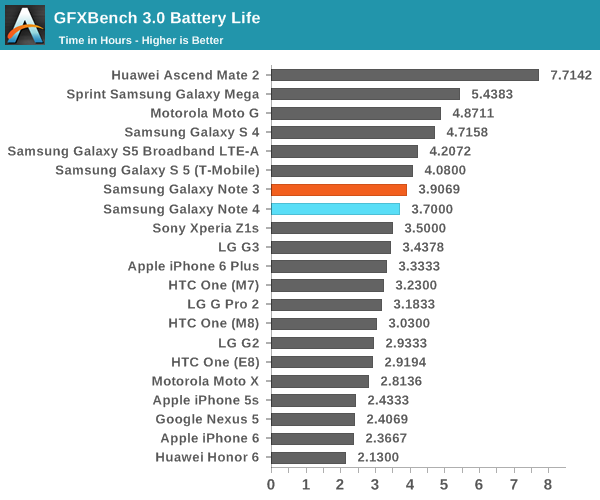
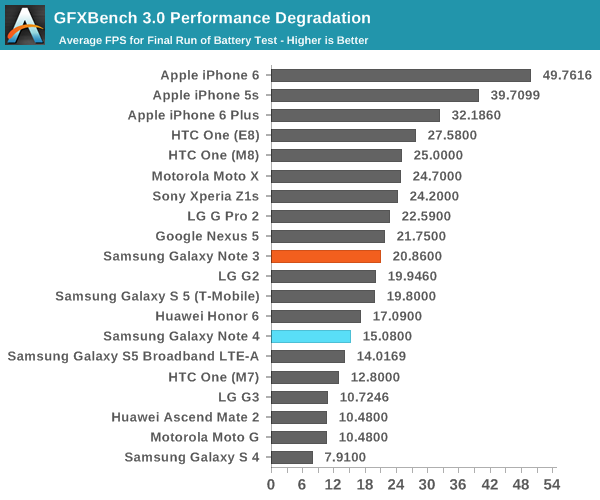
In GFXBench's endless rundown test we see that the Galaxy Note 4 trails behind in battery life when compared to the GS5 LTE-A, but looking at the end of run FPS it’s quite clear that the Galaxy Note 4’s larger surface area makes it possible to achieve greater performance.
Overall, battery life is quite good on the Galaxy Note 4. It’s a massive leap forward when compared to the Galaxy Note 3, but a relatively small one when compared to the Galaxy S5. Once again, we see that most of the benefits in battery life will come from scenarios where power draw isn’t strongly influenced by the display.
Charge Time
As a part of the overall battery life story, it's important to consider the time it takes for a battery to fully charge. If a phone's battery charges slowly then scenarios where charge time becomes crucial will severely hurt real-world battery life. For example, if one forgets to charge their phone at night, the rate at which the phone will charge the battery is a strong influence upon actual battery life. In order to test this, we measure power draw from the time that the device under test is plugged in until it reaches a given level of power draw that indicates that the battery is fully charged.
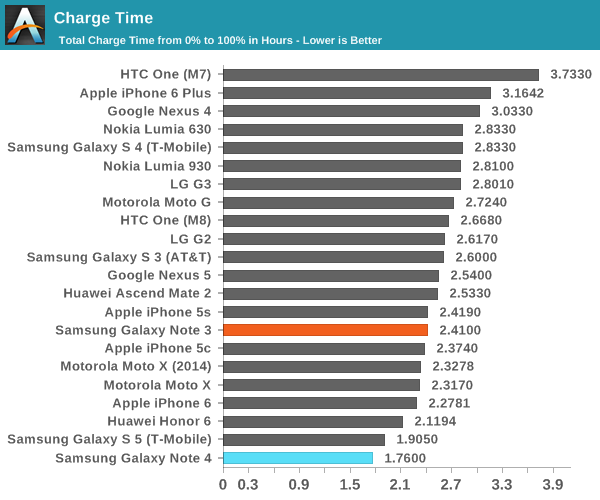
As one can see in the graph above, the adaptive fast-charge mechanism really works, although I don't see a huge benefit when compared to the Galaxy S5's charge time which was already incredibly fast. In the case of the Galaxy Note 4 it seems that it switches between a 9V, 1.64A mode and a 5V, 2A mode as needed, and most of the benefit would come from the first 50% or so of charging as power drops rapidly as the battery approaches full charge.










195 Comments
View All Comments
akdj - Thursday, October 30, 2014 - link
Sorry. Something was lost in translation there;)I'm not going to go tbrough the dozen+ grammatical and punctuation errors, but my point was to compare iOS to Android with their siblings ...the Chromebook and OS X. Windows has the same if they're able to finally figure phones out! The SPIII is a HELLUVA design and enough difference between itself and the iPad (including the price, you're looking more like comparing a nice 13" rMBP w/Haswell ans Iris Pro graphics;))
Vertical and horizontal support. iOS and OS X with continuity and handoff being another extension of Airdrop is absolutely incredible!
The new near 15million pixel 5K iMac is a Grand Slam
iPad Air 2, it's A8X, a 2 and a ½ gen old 64 bit design---2GB of RAM, & a buck 28 built in with a half million 'optomized' tablet apps for everything from photo and video manipulation with Adobe, MS, & OS X integrated and aggregated alls to music creation, mixing and mastering ...magazines that are mind blowing, killer browser choices and unbelievably powerful video editing suites, drawing and sketching programs...old 'Chilton' fix 'em up guides or ForeFlight to file your F/P n tell ya how much gas you should pump in, while it considers diversions and real time weather and traffic. TCAS ans ADSB ...Jep charts, plates and updates in 'now' time, THAT'S a 'Tool!'
Farting around with ROMS is like rewiring your microwave. Why? It's to cook, melt, boil, or pop your F'ung popcorn!
tipoo - Wednesday, October 15, 2014 - link
Indeed. I'm excited for Nvidias Denver CPU cores, finally someone else going with two big cores rather than four small.mpokwsths - Wednesday, October 15, 2014 - link
Something is not right here..."Around 450 nits" with auto brightness on???
Displaymate strongly disagrees with Anandtech. They measured "478 - 750 cd/m2" with auto brightness (1 nit = 1 cd/m2)
http://www.displaymate.com/Galaxy_Note4_ShootOut_1...
melgross - Wednesday, October 15, 2014 - link
There is variability in production. The differences you are seeing are well within that variability.mpokwsths - Wednesday, October 15, 2014 - link
Don't be ridiculous, please...Displaymate: "When Automatic Brightness is turned On, the Galaxy Note 4 reaches an impressive 750 cd/m2 in High Ambient Light, where high Brightness is really needed – it is the brightest mobile display that we have ever tested"
It is an out-of-space claim that there can be a variability in production of a 70% level...
tralalalalalala40 - Saturday, October 18, 2014 - link
hopefully the display doesn't keep that brightness very long. those pentile pixels will burn out. you'll have to use a screen saver.theduckofdeath - Thursday, October 16, 2014 - link
Sounds like a poor excuse for inaccurate testing to me. If the error margin was that huge, the display would be horrible to look at.JoshHo - Wednesday, October 15, 2014 - link
In practice I find that the 100% APL value is more representative of the perceived brightness, this is due to a difference in testing methodology.Pissedoffyouth - Wednesday, October 15, 2014 - link
I just bought a note 3, and I'm more than happy with it with a zerolemon 10000mah battery. This doesn't really offer much more really, more of an slight upgrade.I'd be interested to see why they didn't up the battery a little more considering they made the chassis bigger...
darkich - Wednesday, October 15, 2014 - link
I find it impossible not to notice the Apple reality distortion effect in this article.But nice try hiding it, AT.
I'll just state a fact proven by pretty much every other review - battery endurance on this device is clearly better than that on the iPhone 6+.